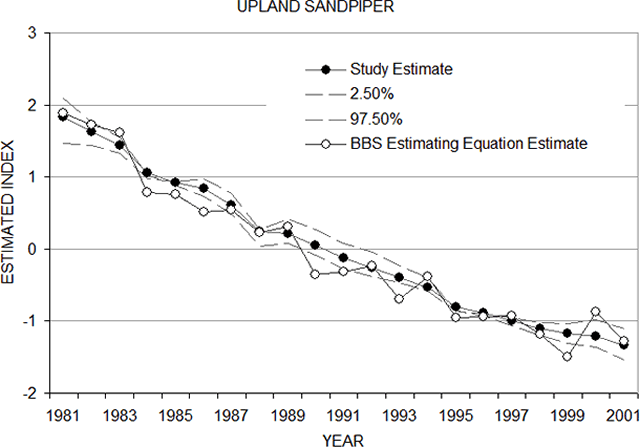Upland Sandpiper (Bartramia Iongicauda)
Systematics:
Kingdom: Animalia Phylum: Chordata Class: Aves
Order: Charadriiformes Family: Scolopacidae
Genus: Bartramia Species: B. longicauda
Ecology:
The Upland Sandpiper, B. longicauda, is a small bird characterized by its long neck, small head, straight bill, long legs, and large eyes. These birds may live up to 4-5 years, the oldest banded bird living 5 years. They are most commonly found in grassland type habitats spanning all of North and South America. Commonly, in the North, Sandpipers, are found nesting at airports. They prefer dry grasslands opposed to wetlands. Their diet is composed of many different insects such as weevils, beetles, grasshoppers and crickets. The Uplands Sandpiper is known for its ground foraging behavior, in which it walks the land preying on insects as it goes. The nest of the Sandpiper is uniquely built into the ground approximately 4 in x 2in and remains either unlined or built up with twigs and leaves. Sandpipers have the tendency to prepare more than one nest, but then only utilize one of them. Upland Sandpiper’s are migratory birds, moving form North to South America during the winter. They spend approximately one month in South America before returning to the North for the Summer months.
Reproduction:
Upland Sandpipers begin to reproduce late April into early May. During courtship, males are commonly known to fly high above females in big circles with their wings outstretched. They ideally mate in grasslands, meadows, prairies, and if need be, wetlands. Breeding areas span anywhere from central Maine to west Canada, southern Alaska to north Texas and over east to central Tennessee. Clutches tend to be composed of 2-7 buff dark spotted eggs. The eggs are incubated by both parents for approximately 21-29 days post laying. Chicks are capable of leaving the nest and feeding themselves almost immediately after hatching. Birds are approximately one year old when they begin to mate. A pair will remain together for approximately one week post eggs hatching, and then the female leaves.
Threats:
B. longicauda, is considered to be a state endangered bird. This is most commonly due to hunting and decreased habitat from the 19th century. The transition of native grasslands to croplands in both North and South America has caused populations to fall. Additionally, as the Passenger Pigeon population fell, hunters turned to the Upland Sandpiper for additional game birds. In Argentina and Paraguay, it has been established that pesticides have been an important factor in the population decline of the Upland Sandpiper, which may additionally, be a contribution to the decline of species in the U.S.
Management:
Currently, it is estimated by the Canadian Wild Life Service that the Upland Sandpiper’s population is approximately 350,000 in total. Most are currently residing in the Great Plains, where they are not considered endangered. Although it is probable they were never abundant in the Northeast, their numbers are dwindling, as well as in the West, with the loss of native grassland habitat. In 1984 Ohio State researchers began encouraging airports to maintain proper management techniques which support the Sandpiper’s living styles in effort to promote dwindling populations. In 2010, the U.S. Shore Bird Conservation created a plan to help restore Upland Sandpiper population. This included raising populations to 126,000 birds in the East by maintaining grazed lands on private cattle ranches, protect large tracts of suitable or potential nesting habitat, manage public grasslands for birds, and provide incentives for private grassland conservation. Currently, in New York efforts to conserve and grow the population is mainly focused on conserving native grasslands.
References
"Upland Sandpiper." , Identification, All About Birds. N.p., n.d. Web. 15 Mar. 2015.
"DEEP: Upland Sandpiper Fact Sheet." DEEP: Upland Sandpiper Fact Sheet. N.p., n.d. Web. 16 Mar. 2015.
Osborne, David R., and A. T. Peterson. "Decline of the Upland Sandpiper (Bartramia, Longicauda) in Ohio: An Endangered Species." Decline of the Upland Sandpiper (Bartramia, Longicauda) in Ohio: An Endangered Species. Ohio State, Mar. 1984. Web. 24 Apr. 2015.
"Disclaimer." Upland Sandpiper Fact Sheet. N.p., n.d. Web. 27 Apr. 2015.
Vickery, Peter D., Daniel E. Blanco, and Bernabe Lopez-Lanus. "Conservation Plan for the Upland Sandpiper." (n.d.): n. pag. Www.whrsrn.org. Western Hemisphere Shorebird Reserve Network, Feb. 2010. Web. 25 Apr. 2015.
Related Posts
Peregrine Falcon
Related Posts
Peregrine Falcon

No comments:
Post a Comment